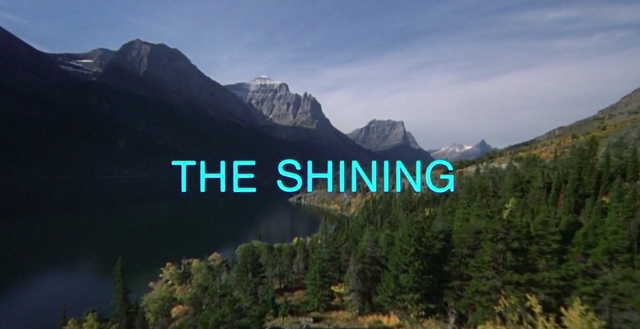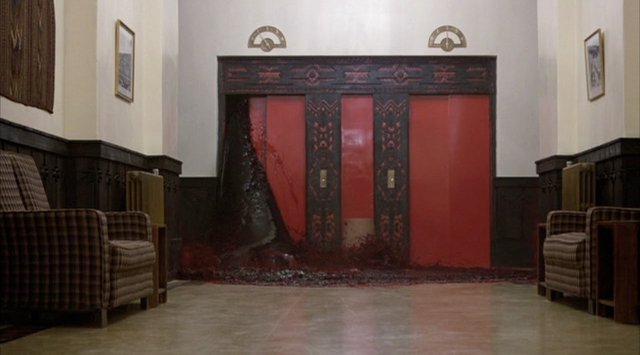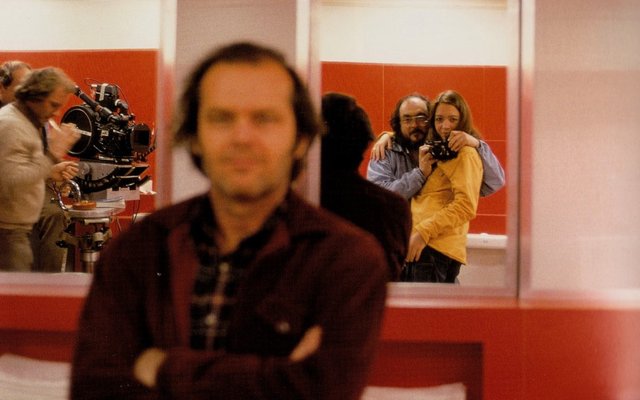Stanley Kubrick - Defining Cinema: Part III

Please do check out Part I and Part II
I signed off Part II reminiscing about the majesty of Barry Lyndon, Kubrick's finest hour. Sadly, the critics and audiences at the time didn't see it as such. Though that's hardly unusual for Kubrick's films - they were decades ahead of their time - Barry Lyndon was the biggest loss endured thus far.
Warner Bros didn't complain - they continued their carte blanche offer. Kubrick, however, felt somewhat of a responsibility to deliver something more commercial, while still retaining his penchant for each new film being a fresh, unprecedented experience. No one at the time believed Kubrick would ever do horror - a genre perhaps too philistine for Kubrick's ambitions. But so he did, setting out to adapt Stephen King's The Shining.

Stanley Kubrick and Stephen King don't seem like a particularly obvious match, and indeed, Kubrick's The Shining is pretty far removed from Stephen King's novel. A mini-series later stuck much closer to The Shining to sorry effect.
Kubrick's last five films, which though take liberal inspiration from fellow filmmakers, were wholly original and unprecedented. The Shining though, has a close counterpart that preceded it - Eraserhead. The idea was not to "scare" the audience through moments of disturbing imagery, or through the characters' horrors, but to engulf the audience in a thick atmosphere of fear and uncertainty. Yes, the traditional horror elements mentioned above come through, but only after the atmosphere has been established.
Casting Jack Nicholson lent The Shining considerable commercial power, and fulfils another goal interrupted by Napoleon's cancelation. Equally bold casting decisions were Shelley Duvall and Scatman Crothers, while Danny Llyod played the son in his only film role.
The Shining is perhaps the most studied film in history, with several essays, books and even entire feature length films dedicated to decoding it. Room 237 is perhaps the more famous, but there are others, reaching well into conspiracy theory territory. I mentioned the multiple narrative layers Kubrick was obsessed about - they are most obvious in The Shining. Of course, there's no conspiracy, and some of these interpretations are well mad. But that's what Kubrick intended, to really engage the audience, and no film has succeeded so admirably.

While Kubrick loved to work in secrecy, The Shining is also the most documented of his productions, mostly due to Making The Shining directed by Vivian (his daughter). It's a pretty common myth that Kubrick was an obsessive, manipulative perfectionist who would micro-manage every last detail. Nothing of the sort, in The Shining, we can clearly see a very playful Stanley Kubrick improvising, coming up with some famous shots at the last minute; even re-writing the screenplay moments before shooting a scene. That said, it was an arduous shoot that took its toll on everyone involved.
Influenced greatly by Max Ophuls in his early years, Kubrick sought for years to free the camera from. Perhaps the most exciting invention for Kubrick, then, was the Steadicam. Invented in 1976, right after Barry Lyndon, it's a rig that'd stabilize camera movements, so the camera would appear to float even if a man ran with it. This was a huge breakthrough for Kubrick, and indeed, you could see several shots designed specifically for the Steadicam. None more so than the tricycling shots, aided by the eerie sound effect.
Above all, Kubrick built up the atmosphere through both stark imagery and hard hitting music, in combination with a slow burn examination of the characters. At the end comes the traditional payoff, and because of this intense development that went before it, is scarier and more impactful than any horror film ever made.
"Pinnochio"
At barely fifty years old, Stanley Kubrick had already reinvented every genre there is. Except perhaps, action. There were talks of Kubrick directing a James Bond film, but nothing materialised. That said, his old collaborator, production designer Ken Adams was stuck on a set for The Spy Who Loved Me. Who better to call for advice than Stanley Kubrick? He smuggled Stanley into the set, and spent the remaining four hours covertly lighting the set.
Shortly after The Shining, Kubrick sought a return to the science fiction genre. He collaborated with Brian Aldiss on an adaption for his short story Supertoys Last All Summer Long. Kubrick affectionately called this project Pinnochio, except it involved a futuristic setting with a robot playing Pinnochio.
After a couple of years, Kubrick shelved the project, preferring to wait for CGI technology to catch up to his vision. Instead, he turned to another genre he had previously visited - War.

Needless to say, Full Metal Jacket was unlike any war film ever made. It featured Kubrick's usual "multiple short film" narrative structure, but here it was even bolder, with each segment featuring a completely different tone.
The real star of Full Metal Jacket is of course R. Lee Ermey. Initially hired as a technical advisor thanks to his deep experience in the US Marine Corps and on Apocalypse Now, he soon became a close collaborator. Much of the incredible and hilarious training sequences early in the film were actually conceived and written by Ermey himself. Stanley gave him full freedom, and boy, he delivered. Many of the long, colourful monologues were shot in two or three takes. Of course, both of these totally contradict the myths of "hundred take Kubrick" or "maniacal control freak Kubrick".
Full Metal Jacket's greatest success is how it moves from segment to segment seamlessly, yet each segment is a different story, showing a side of War rarely captured on film. Yet, this is what baffled many audiences, who went in expecting an Apocalypse Now. Full Metal Jacket to this day remains one of his most "underrated" works, though one that's rising to prominence, three decades later. A great companion to Full Metal Jacket is David Simon's Generation Kill, also examining the perspective of the men right in the thick of war.
Finally, it's hard not to compare Paths of Glory to Full Metal Jacket. Fundamentally, FMJ did to Vietnam War as Paths did to World War I. Yet, they are completely different wars, and thus, completely different films. Building on Paths of Glory's amazing trench sequences, the Steadicam now finally gave Kubrick full freedom to capture large scale battle sequences. Of course, the Steadicam shots were kept somewhat unstable to mimic newsreel footage. A decade later, Spielberg further innovated on this idea - an idea initiated with Paths of Glory.
Aryan Papers and Artificial Intelligence
A film about The Holocaust seems right up Stanley Kubrick's alley - dealing with the grand themes of what drives good men to evil. First interested in a Holocaust film following Barry Lyndon, Kubrick's penchant for the Holocaust was rekindled by Louis Begley's novel "Wartime Lies".
Like Napoleon, Aryan Papers was greenlit and at a fairly advanced stage of pre-production. By this time, Stanley Kubrick and Steven Spielberg were great friends. When Kubrick came to know about Schindler's List, Warner Bros and Kubrick came to a joint decision to shelf the project. Stanley's wife Christiane later admitted that Aryan Papers had taken a toll on his wellbeing, and it was for the best.
Schindler's List was met to a rousing reception, but Spielberg released another masterpiece the same year - Jurassic Park.
Encouraged by the progress of CGI, Kubrick then moved back to his 80s project "Pinnochio". Much to Aldiss' chagrin, Kubrick hired Ian Watson to rewrite the screenplay.
Artists are stereotypically extremely arrogant and self-centred - and indeed, this is a fair assessment overall. Not Stanley Kubrick. He realized Steven Spielberg would be the right director for Pinnochio - now Artificial Intelligence. He felt AI would be a better Spielberg film than a Kubrick film. After a couple of years of work, Kubrick passed on the project to Spielberg.

Having suffered from censorship forty and thirty years ago with Lolita and A Clockwork Orange respectively, the world had finally caught up to Stanley Kubrick's vision. It was time for a brutally honest film about the sexual lives and fantasies of a modern day couple.
Taking inspiration from Arthur Schnitzler's Traumnovelle, Eyes Wide Shut may be Kubrick's most daring, most no-holds-barred film. If there was one film that defined Kubrick as a filmmaker, it has got to be Eyes Wide Shut.
Featuring career highlight performances from Nicole Kidman and Tom Cruise (though his turn in Magnolia the same year was quite spectacular too) builds a dreary, surreal atmosphere. It has to be experienced to be believed, and seen multiple times.
It says a lot that two of the top Hollywood movie stars at the time put their careers on hold and were at Kubrick's complete mercy for nearly two years. To this very day, Eyes Wide Shut is the longest continuous shoot in film history, shot over 400 days. The crew would take their time, spend several days if not weeks on single scenes, getting everything just right. Note - not perfect, but right.
Much like The Shining, Eyes Wide Shut gives up some of the humour omnipresent in Kubrick's previous films for an oppressive atmosphere, and this, as with every Kubrick film, led to a mixed reaction from the audience. Give it till 2020 though - this will be recognized as the masterwork it truly is, even though it's not my favourite.
Days after locking the edit for Eyes Wide Shut, Stanley Kubrick passed away in his sleep at the ripe young age of 70. Two years later, Steven Spielberg fulfilled his vision for AI: Artificial Intelligence. There couldn't be a more fitting tribute to one of the finest artists of the twentieth century.

References
Stanley Kubrick: A Life in Pictures, directed by Jan Harlan
Stanley Kubrick: The Complete Films by Paul Duncan
The Philosophy of Stanley Kubrick by Jerold Abrams
http://www.visual-memory.co.uk/amk/doc/0047.html
http://www.artofthetitle.com/
https://www.reddit.com/r/movies/comments/31b9nw/during_the_filming_of_the_spy_who_loved_me/
http://www.haaretz.com/print-edition/features/eyes-wide-open-1.167674
This post has been ranked within the top 80 most undervalued posts in the second half of Dec 23. We estimate that this post is undervalued by $4.44 as compared to a scenario in which every voter had an equal say.
See the full rankings and details in The Daily Tribune: Dec 23 - Part II. You can also read about some of our methodology, data analysis and technical details in our initial post.
If you are the author and would prefer not to receive these comments, simply reply "Stop" to this comment.
Excellent third part.
His daughter said that they asked him to remove the last 30 minute of the film (Eyes Wide Shut) and he refused, shortly after he died. They cut that part anyways and that's why the movie ends like that, in the middle of a random conversation.
I don't know how much truth is in there though. :P
The edit was locked a couple of weeks before he died, and mostly unchanged. That's gotta be the ending SK intended!
Cut to black.
That's an awesome ending!
I'm pretty sure I learned about this in a Reddit AMA with his daughter Katharina - some shots were cut out from the orgy scene, the reason being Warner Bros had contracted Kubrick to produce an R rated film. That had to be done after his death, but it's likely he would have agreed to those cuts anyway. Let me try and fish out a link to that!
Of course, there might some regional versions that were horribly censored, but the master copy was as he intended.
Edit - Found it! https://www.reddit.com/r/IAmA/comments/134rvs/stanley_kubricks_daughter_katharina_kubrick_and/c70xidf/?
So he did participate in the censoring just that it had to be executed after he died.
Wow! Thanks for the detailed answer Sen!
All I knew was hearsay, this is very insightful.
Yeah I've seen one that was censored and one that wasn't, but that depended on air time I guess.
Very interesting film, you dive into it.
Great article.
Have you heard about the theory of Kubrick being contracted by the government to help fake the moon landing? Something about his use and development of the front projection effect.
https://en.wikipedia.org/wiki/Front_projection_effect
I wouldn't call it a "theory". It's just another baseless conspiracy.
Baseless??? ;)